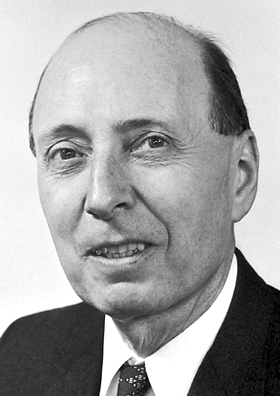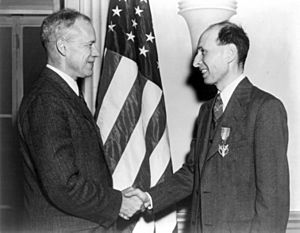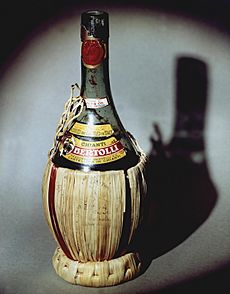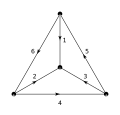Eugene Wigner facts for kids
Quick facts for kids
Eugene Wigner
|
|
|---|---|

Wigner in 1963
|
|
| Born |
Wigner Jenő Pál
November 17, 1902 |
| Died | January 1, 1995 (aged 92) Princeton, New Jersey, U.S.
|
| Citizenship |
|
| Alma mater | Technical University of Berlin |
| Known for |
|
| Spouse(s) |
Amelia Frank
(m. 1936; died 1937)Mary Annette Wheeler
(m. 1941; died 1977)Eileen Clare-Patton Hamilton
(m. 1979) |
| Children | 3 |
| Awards |
|
| Scientific career | |
| Fields | |
| Institutions | |
| Thesis | Bildung und Zerfall von Molekülen (1925) |
| Doctoral advisor | Michael Polanyi |
| Other academic advisors |
|
| Doctoral students |
|
| Signature | |
Eugene Paul Wigner (born Wigner Jenő Pál) was a brilliant Hungarian-American theoretical physicist. He was born on November 17, 1902, and passed away on January 1, 1995. In 1963, he won the Nobel Prize in Physics. He earned this award for his important work on the atomic nucleus (the center of an atom) and tiny elementary particles. He especially helped us understand how symmetry works in physics.
Wigner studied at the Technical University of Berlin. He later moved to the United States and became a citizen in 1937. He taught at Princeton University. During World War II, he played a key role in the Manhattan Project. This was a secret project to develop the first atomic bombs.
Contents
Early Life and Education

Eugene Wigner was born in Budapest, which was part of Austria-Hungary at the time. His parents were Elisabeth and Antal Wigner. He had two sisters, Berta and Margit. Margit later married another famous physicist, Paul Dirac. Eugene was homeschooled until he was nine. He loved solving math problems even when he was young.
From 1915 to 1919, he attended a secondary school called Fasori Gimnázium. A year behind him was John von Neumann, who also became a very famous mathematician. Both learned a lot from their amazing math teacher, László Rátz. In 1919, Wigner's family briefly moved to Austria to avoid a communist government in Hungary. When they returned, they changed their religion to Lutheranism. Wigner later said this was more about politics than religion.
After high school, Wigner studied chemical engineering in Berlin, Germany. He went to many physics talks where he met top scientists like Max Planck and Albert Einstein. He also became close friends with physicist Leó Szilárd. While in Berlin, Wigner worked with Michael Polanyi, who became another important teacher for him. Polanyi helped Wigner with his doctoral thesis on how molecules form and break apart.
Developing New Physics Ideas
After his studies, Wigner worked in Budapest for a short time. In 1926, he went back to Berlin to help with X-ray studies of crystals. He then started exploring quantum mechanics, which is a branch of physics that studies matter and energy at the smallest levels. He also studied group theory, a type of mathematics that deals with symmetry.
Wigner then worked at the University of Göttingen in Germany. He focused on how symmetry works in quantum mechanics. In 1927, he introduced something called the Wigner D-matrix. Wigner and Hermann Weyl were pioneers in bringing group theory into physics. Wigner wrote a book, Group Theory and Its Application to the Quantum Mechanics of Atomic Spectra (1931). This book made complex group theory ideas easier for other physicists to understand.
His work laid the groundwork for understanding symmetries in quantum mechanics. Wigner's theorem, which he proved in 1931, is a key idea in quantum mechanics. It explains how physical symmetries, like rotations or movements, are shown in the mathematical space of quantum states.
In the late 1930s, Wigner started researching the structure of atomic nuclei. His papers were gaining attention in the physics world. In 1930, Princeton University in the United States invited Wigner to teach. He moved to the US with his friend John von Neumann. They both changed their first names to "Eugene" and "John." In 1934, Wigner introduced his sister Margit to physicist Paul Dirac, and they later married.
Princeton did not renew Wigner's contract in 1936. He found a new job at the University of Wisconsin. There, he met his first wife, Amelia Frank, who was a physics student. Sadly, she passed away in 1937. Wigner was very sad, but he accepted an offer to return to Princeton in 1938. He became a US citizen on January 8, 1937, and brought his parents to America.
Role in the Manhattan Project
Even though he wasn't very involved in politics, Eugene Wigner played a big part in history. On August 2, 1939, he met with Leó Szilárd and Albert Einstein. This meeting led to the Einstein–Szilárd letter. This letter convinced President Franklin D. Roosevelt to start the Manhattan Project. The goal was to build atomic bombs. Wigner was worried that Germany might build an atomic bomb first.
On June 4, 1941, Wigner married his second wife, Mary Annette Wheeler. She was a physics professor. They had two children, David and Martha. Mary taught physics until she retired in 1964. They were married until she passed away in 1977.
During the Manhattan Project, Wigner led a team. Their job was to design special nuclear reactors. These reactors would turn uranium into plutonium, which was needed for the bombs. At that time, reactors only existed as ideas on paper. No reactor had ever worked before. In July 1942, Wigner chose a design for a 100-megawatt reactor. It would use graphite to slow down neutrons and water for cooling.
Wigner was there on December 2, 1942, at the University of Chicago. This was when the world's first atomic reactor, called Chicago Pile-1, successfully created a controlled nuclear chain reaction. This was a huge step forward!
Wigner was a bit frustrated that the company DuPont was given control over the detailed design of the reactors. He felt this should have been his team's job. However, a design choice by DuPont to add more tubes for uranium actually saved the project later on. This was important when a problem called "neutron poisoning" came up.
An important discovery Wigner made during the project was the Wigner effect. This is when graphite, used in reactors, swells up. This happens because atoms are moved around by neutron radiation. The Wigner effect caused problems for reactors after the war. But scientists eventually found a way to fix it by carefully heating and cooling the graphite.
Later Years and Recognition
In early 1946, Wigner became the Director of Research and Development at the Clinton Laboratory (now Oak Ridge National Laboratory). He didn't like administrative tasks, so he shared the leadership role. When the United States Atomic Energy Commission (AEC) took over, Wigner worried that decisions would be made far away in Washington. He also felt that strict security rules from the war were getting in the way of research.
Feeling that a management role wasn't for him, he left Oak Ridge in 1947. He returned to Princeton University, but he continued to advise the laboratory for many years. After the war, he served on several government groups. These included the National Bureau of Standards and the General Advisory Committee of the United States Atomic Energy Commission. He also helped with civil defense planning.
Later in his life, Wigner thought more about philosophical questions. In 1960, he wrote a famous article called "The Unreasonable Effectiveness of Mathematics in the Natural Sciences". In this paper, he wondered why mathematics is so incredibly good at describing the natural world. He found it "unreasonable" how well they matched up.
In November 1963, Wigner suggested that 10% of the national defense budget should be spent on nuclear blast shelters and survival resources. He believed this would be less costly than disarmament.
Wigner received the Nobel Prize in Physics in 1963. He shared the prize with Maria Goeppert Mayer and J. Hans D. Jensen. He was very surprised to win! He also received many other awards, including the Franklin Medal in 1950 and the National Medal of Science in 1969.
Mary, his second wife, passed away in 1977. In 1979, Wigner married his third wife, Eileen Clare-Patton Hamilton. In 1992, at 90 years old, he published his memories in a book called The Recollections of Eugene P. Wigner. He wrote that the full meaning of life is a mystery beyond our understanding. He said he had made peace with this idea and felt honored to be part of such a mystery.
Eugene Wigner passed away from pneumonia on January 1, 1995, in Princeton, New Jersey. He left behind his wife Eileen, his children, and his sisters.
Images for kids
See also
 In Spanish: Eugene Paul Wigner para niños
In Spanish: Eugene Paul Wigner para niños
- List of things named after Eugene Wigner
- The Martians (scientists)




